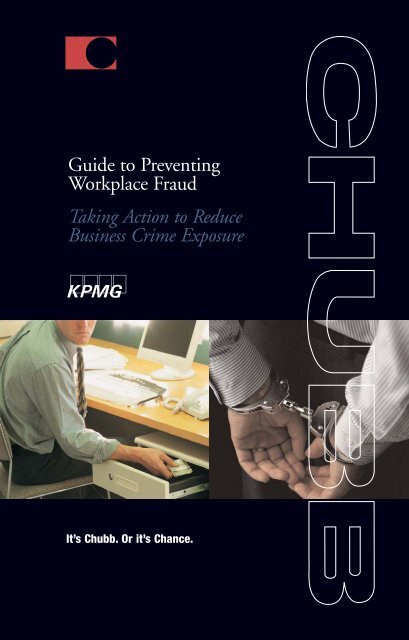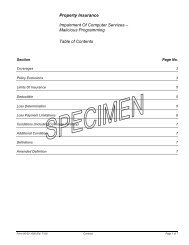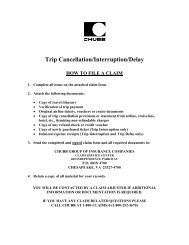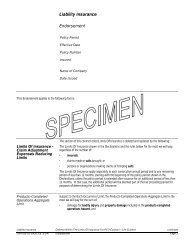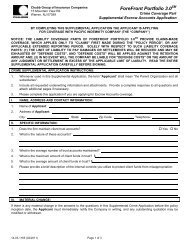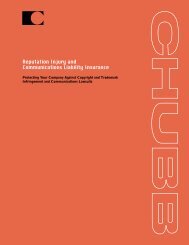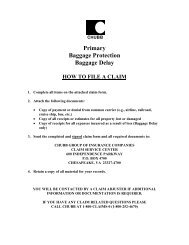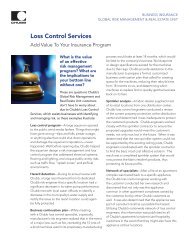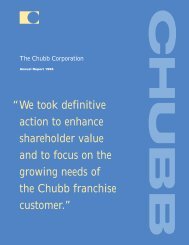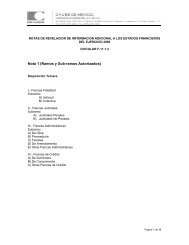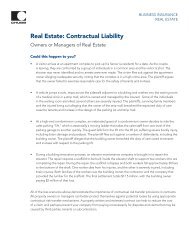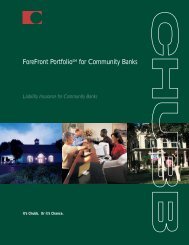Guide to Preventing Workplace Fraud - Chubb Group of Insurance ...
Guide to Preventing Workplace Fraud - Chubb Group of Insurance ...
Guide to Preventing Workplace Fraud - Chubb Group of Insurance ...
Create successful ePaper yourself
Turn your PDF publications into a flip-book with our unique Google optimized e-Paper software.
<strong>Guide</strong> <strong>to</strong> <strong>Preventing</strong><br />
<strong>Workplace</strong> <strong>Fraud</strong><br />
Taking Action <strong>to</strong> Reduce<br />
Business Crime Exposure<br />
It’s <strong>Chubb</strong>. Or it’s Chance.
©2006 KPMG LLP, the U.S. member firm <strong>of</strong> KPMG International, a Swiss<br />
cooperative. All rights reserved. KPMG and the KPMG logo are registered<br />
trademarks <strong>of</strong> KPMG International, a Swiss cooperative.
GUIDE TO PREVENTING<br />
WORKPLACE FRAUD<br />
TAKING ACTION TO REDUCE<br />
BUSINESS CRIME EXPOSURE<br />
“Honesty pays, but it doesn’t seem<br />
<strong>to</strong> pay enough <strong>to</strong> suit some people.”<br />
—F. M. Hubbard
PREFACE<br />
Regardless <strong>of</strong> size, all organizations are vulnerable <strong>to</strong> workplace fraud. <strong>Fraud</strong><br />
can take many forms—including embezzlement, forgery, theft <strong>of</strong> inven<strong>to</strong>ry<br />
and other assets, and computer crime—and can continue unchecked for<br />
years. The financial impact on an organization <strong>of</strong> these so-called “whitecollar”<br />
crimes can be devastating.<br />
As a leading provider <strong>of</strong> crime insurance (sometimes known as fidelity<br />
bond), the <strong>Chubb</strong> <strong>Group</strong> <strong>of</strong> <strong>Insurance</strong> Companies believes the most costeffective<br />
way <strong>to</strong> deal with fraud is <strong>to</strong> prevent it. Although insurance can help<br />
recoup some monetary losses resulting from fraud, other losses can never be<br />
recovered, such as losses resulting from adverse publicity, the disruption <strong>of</strong><br />
operations, and time spent with law enforcement <strong>of</strong>ficials and others.<br />
However, the consistent application <strong>of</strong> sound risk management practices can<br />
minimize opportunities for white-collar crime, helping <strong>to</strong> spare an<br />
organization the financial loss—and humiliation—that can result from a<br />
determined employee’s fraud scheme.<br />
We asked KPMG Forensic SM , a firm that specializes in fraud detection and<br />
prevention, <strong>to</strong> prepare the <strong>Guide</strong> <strong>to</strong> <strong>Preventing</strong> <strong>Workplace</strong> <strong>Fraud</strong> <strong>to</strong> help our<br />
Crime <strong>Insurance</strong> cus<strong>to</strong>mers develop loss prevention strategies designed <strong>to</strong><br />
reduce their exposure <strong>to</strong> white-collar crime. This booklet discusses the threat<br />
posed by various types <strong>of</strong> fraud, reviews common types <strong>of</strong> fraud schemes,<br />
and suggests specific risk management strategies.<br />
Although we believe the <strong>Guide</strong> <strong>to</strong> <strong>Preventing</strong> <strong>Workplace</strong> <strong>Fraud</strong> is a good<br />
starting point for companies that want <strong>to</strong> develop or review their loss<br />
prevention strategies, it is not a substitute for expert advice. We encourage<br />
the reader <strong>to</strong> seek appropriate pr<strong>of</strong>essional advice for any specific issues that<br />
arise when designing and implementing loss prevention strategies.<br />
1
CONTENTS<br />
Introduction ............................................................................................5<br />
The Threat <strong>of</strong> <strong>Fraud</strong> ................................................................................7<br />
Defining <strong>Fraud</strong> ................................................................................7<br />
The <strong>Fraud</strong> Triangle ..........................................................................8<br />
The Types <strong>of</strong> <strong>Fraud</strong> ................................................................................11<br />
Asset Misappropriation ..................................................................11<br />
<strong>Fraud</strong>ulent Financial Statements, Books, and Records ....................13<br />
Corrupt or Prohibited Practices ......................................................13<br />
<strong>Fraud</strong> Risk Management—Loss Control Considerations ......................14<br />
Common <strong>Fraud</strong> Schemes ......................................................................25<br />
Vendor Schemes ............................................................................25<br />
Cash-Skimming Schemes ................................................................28<br />
<strong>Fraud</strong>s Related <strong>to</strong> Company Checks ..............................................29<br />
Accounts Receivable/Incoming Payment Processing ......................34<br />
Misappropriation <strong>of</strong> Waste, Scrap, and Salvage Property ................36<br />
Conflicts <strong>of</strong> Interest, Kickbacks, Bribes,<br />
and Employee Corruption ..............................................................37<br />
Expense Account Reimbursement <strong>Fraud</strong> ........................................38<br />
Payroll <strong>Fraud</strong> ..................................................................................39<br />
Use <strong>of</strong> Company Funds <strong>to</strong> Pay Personal Expenses ..........................42<br />
Computer-Related <strong>Fraud</strong> ................................................................43<br />
Responding <strong>to</strong> the Threat <strong>of</strong> <strong>Fraud</strong> ......................................................45<br />
Fundamental Elements <strong>of</strong> Corporate Governance ..........................46<br />
Final Thoughts on <strong>Fraud</strong> Risk and Response ........................................51<br />
About This Booklet ..............................................................................52<br />
3
INTRODUCTION<br />
Understanding the impact <strong>of</strong> workplace fraud, and the potential losses<br />
associated with fraud and establishing effective loss control measures are<br />
critical for companies from cost, cultural, and risk management perspectives.<br />
■<br />
<strong>Workplace</strong> fraud is a common, everyday occurrence. Every<br />
business—large or small—is vulnerable <strong>to</strong> these crimes.<br />
■<br />
<strong>Workplace</strong> fraud can have a substantial impact on a business’s<br />
“bot<strong>to</strong>m line” and even on its continued survival and success. The<br />
financial impact <strong>of</strong> workplace fraud can be significant and can occur<br />
in the form <strong>of</strong> direct, indirect, and/or intangible costs. In addition <strong>to</strong><br />
direct losses <strong>of</strong> tangible assets, such as cash, inven<strong>to</strong>ry, and securities,<br />
loss <strong>of</strong> competitive advantage, reduced ability <strong>to</strong> meet cus<strong>to</strong>mer needs,<br />
reputation impairment, and disruption <strong>of</strong> business operations are<br />
some <strong>of</strong> the potential indirect and/or intangible costs <strong>to</strong> a business.<br />
■<br />
The challenge <strong>of</strong> combating fraud directed against a business is<br />
increased by the diversity and deceptive nature <strong>of</strong> those crimes.<br />
Deception is a key element <strong>of</strong> workplace fraud, and a company may<br />
realize <strong>to</strong>o late that it has been victimized.<br />
■<br />
An appropriate response <strong>to</strong> the threat <strong>of</strong> workplace fraud requires<br />
understanding potential areas that are “at risk,” recognizing the<br />
fraud-related threats, and understanding the potential fraudorigination<br />
points, both internal and external.<br />
Although it is not possible <strong>to</strong> completely eliminate fraud risk, it is possible<br />
<strong>to</strong> reduce the risk and <strong>to</strong> minimize fraud-related losses and other<br />
consequences through effective loss control measures. Reduction <strong>of</strong> fraud<br />
risk requires a thoughtful, comprehensive, and proactive approach. <strong>Fraud</strong><br />
risk management includes establishing effective loss control measures that<br />
5
focus on prevention, detection, and response. Given the potential<br />
costs <strong>of</strong> workplace fraud, proactive fraud risk management makes good<br />
business sense.<br />
6
THE THREAT OF FRAUD<br />
Bot<strong>to</strong>m line: Businesses are targets for crime because they have something<br />
<strong>of</strong> economic value. <strong>Fraud</strong> perpetra<strong>to</strong>rs believe that they can successfully steal,<br />
compromise, or use some <strong>of</strong> that value.<br />
There is virtually no limitation <strong>to</strong> the means that may be employed <strong>to</strong><br />
accomplish a criminal objective. The criminal mind is ever alert <strong>to</strong> seemingly<br />
new and unique ways <strong>to</strong> separate a business from its assets. Crimes that<br />
businesses face generally may be categorized as:<br />
■<br />
“Street crime,” such as robbery and burglary.<br />
■<br />
“White-collar crime,” such as fraud, misconduct, and related<br />
financial threats.<br />
The focus <strong>of</strong> this booklet is on the white-collar fraud threat.<br />
Defining <strong>Fraud</strong><br />
Anti-fraud pr<strong>of</strong>essionals agree that fraud (and misconduct) encompasses<br />
activities involving dishonesty and deception that can drain value from a<br />
business, either directly or indirectly, whether or not the perpetra<strong>to</strong>r(s)<br />
benefit. <strong>Fraud</strong> involves the intent <strong>to</strong> defraud; that is, the perpetra<strong>to</strong>r relies on<br />
his or her deception <strong>to</strong> accomplish—or hide—the fraudulent activity. <strong>Fraud</strong><br />
is not accomplished via honest mistake or error.<br />
<strong>Fraud</strong> can manifest itself in a wide variety <strong>of</strong> ways and originate from a<br />
number <strong>of</strong> different sources. <strong>Fraud</strong> that is perpetrated by employees,<br />
consumers, and vendors dominates most instances <strong>of</strong> fraud experienced<br />
by businesses.<br />
Understanding the fraud threats against your business, as well as why fraud<br />
typically occurs, are first steps in analyzing fraud risk and developing an<br />
appropriate plan for managing that risk.<br />
7
The <strong>Fraud</strong> Triangle<br />
What motivates people <strong>to</strong> commit fraud? Criminologists have identified<br />
three elements that are <strong>of</strong>ten present when fraud occurs. These three<br />
elements form the “fraud triangle.” 1<br />
OPPORTUNITY<br />
PRESSURE OR<br />
INCENTIVE<br />
RATIONALIZATION<br />
The <strong>Fraud</strong> Triangle<br />
“Opportunity” refers <strong>to</strong> the situations and circumstances that make it<br />
possible for fraud <strong>to</strong> take place. For example, an employee with uncontrolled<br />
access <strong>to</strong> company funds has the opportunity <strong>to</strong> misappropriate those funds.<br />
Opportunity is, generally, the element that a business can most effectively<br />
influence, impact, and control. An important action a business can take <strong>to</strong><br />
reduce crime exposure is <strong>to</strong> assess the opportunity for fraud and respond<br />
accordingly. Responding <strong>to</strong> fraud risk includes development and use <strong>of</strong><br />
effective internal controls <strong>to</strong> reduce, mitigate, or even eliminate<br />
opportunities for fraud.<br />
“Pressure or incentive” helps explain why and when fraud occurs. <strong>Fraud</strong><br />
takes place when fraud pressures or incentives outweigh, and ultimately<br />
1 Dr. Donald R. Cressey is generally credited with developing the concept <strong>of</strong> the fraud triangle,<br />
according <strong>to</strong> the 2005 <strong>Fraud</strong> Examiners Manual (Association <strong>of</strong> Certified <strong>Fraud</strong> Examiners).<br />
8
overcome, the pressures or incentives <strong>to</strong> act honestly. Thus, pressures or<br />
incentives can become the motivation <strong>to</strong> act fraudulently. Pressures and<br />
incentives <strong>to</strong> commit fraud are <strong>of</strong>ten associated with:<br />
■<br />
Lifestyle issues (living beyond one’s means).<br />
■<br />
Personal debt (e.g., excessive credit card use, gambling losses, use <strong>of</strong><br />
drugs or alcohol).<br />
■<br />
Business results (e.g., poor operating results, desire <strong>to</strong> avoid business<br />
failure, meet requirements <strong>of</strong> lenders).<br />
If a company can recognize when and where excessive pressure/incentives<br />
may be present, it can use that information in fraud prevention and<br />
detection efforts and take action <strong>to</strong> mitigate business-related<br />
pressures/incentives in order <strong>to</strong> reduce fraud risk.<br />
An effective fraud prevention program can increase pressures and incentives <strong>to</strong><br />
act honestly by emphasizing a “perception <strong>of</strong> detection,” underscored by the<br />
company’s demonstrated, consistent commitment <strong>to</strong> taking appropriate and<br />
certain action once fraud is discovered.<br />
“Rationalization” refers <strong>to</strong> the need for people <strong>to</strong> somehow justify their<br />
fraudulent actions in their own minds. A person involved in a fraud<br />
attempts <strong>to</strong> psychologically accept his/her own actions and emotionally<br />
“shift the blame” <strong>to</strong> anyone or anything other than him/herself.<br />
Common rationalizations include:<br />
■<br />
Entitlement: “They don’t pay me what I’m worth. I have this money<br />
coming <strong>to</strong> me.”<br />
■<br />
Anger or revenge: “The company has treated me poorly; now they’re<br />
going <strong>to</strong> pay.”<br />
9
■<br />
Minimization: “I’m not taking very much. The company can easily<br />
afford it.”<br />
■<br />
Moral justification: “Everyone else is doing it, so it must not be so<br />
bad <strong>to</strong> do this.”<br />
Rationalizations are not generally known <strong>to</strong> others and therefore are usually<br />
difficult <strong>to</strong> detect. In addition, persons with low moral integrity may feel<br />
little need <strong>to</strong> rationalize their behavior.<br />
10
THE TYPES OF FRAUD<br />
The Association <strong>of</strong> Certified <strong>Fraud</strong> Examiners (ACFE) categorizes fraud<br />
threats <strong>to</strong> businesses in the following ways:<br />
■<br />
Asset misappropriation,<br />
■<br />
<strong>Fraud</strong>ulent financial statements and records, and<br />
■<br />
Corrupt or prohibited practices.<br />
Asset Misappropriation<br />
Simply put, asset misappropriation can be thought <strong>of</strong> as a theft <strong>of</strong> something<br />
<strong>of</strong> value that belongs <strong>to</strong> your business. When it comes <strong>to</strong> asset<br />
misappropriation, “cash is king.” In other words, cash is the most frequently<br />
targeted asset.<br />
Consider:<br />
■<br />
According <strong>to</strong> a 2004 national survey by the ACFE, 93% <strong>of</strong> the asset<br />
misappropriation cases studied involved cash, and the median loss<br />
was $93,000.<br />
■<br />
“Cash” targets include currency and coins, checks, electronic funds,<br />
financial instruments, rebates, credits, discounts, and virtually any<br />
other device or means <strong>of</strong> financial exchange or enrichment.<br />
■<br />
Cash is targeted for obvious reasons—it has a clearly known value, is<br />
easily transferable and transportable, is difficult <strong>to</strong> trace, and may even<br />
be diverted before any record exists on company books.<br />
■<br />
Cash may be targeted by external or internal perpetra<strong>to</strong>rs or even by<br />
both via collusion.<br />
11
Cash-diversion schemes range from simple skimming <strong>of</strong> sales receipts <strong>to</strong><br />
complex frauds involving:<br />
■<br />
Billing,<br />
■<br />
Payroll,<br />
■<br />
Expense reimbursement,<br />
■<br />
Checks, including alteration and diversion <strong>of</strong> legitimately issued<br />
checks, and<br />
■<br />
Sales and remittances, including point-<strong>of</strong>-sale “till tapping.”<br />
Other common targets <strong>of</strong> asset misappropriation include merchandise<br />
and/or other inven<strong>to</strong>ry, equipment and supplies, and even waste, scrap,<br />
salvage, or surplus property.<br />
Generally, high-value assets that are easy <strong>to</strong> transport and <strong>to</strong> dispose <strong>of</strong> are at<br />
highest risk. Prime examples <strong>of</strong> high-risk assets include lap<strong>to</strong>p computers,<br />
which pose the additional risks <strong>of</strong> confidential data disclosure and possible<br />
facilitation <strong>of</strong> unauthorized information-system intrusion.<br />
Experience indicates that virtually any type <strong>of</strong> asset can be targeted.<br />
Company services may also be appropriated. For example:<br />
■<br />
A manager <strong>of</strong> a construction firm uses “on the clock” company<br />
employees <strong>to</strong> remodel his home, or perform landscaping and/or<br />
maintenance work.<br />
■<br />
An administrative assistant uses her employer’s express mail delivery<br />
service account <strong>to</strong> routinely send packages <strong>to</strong> members <strong>of</strong> her family<br />
in other parts <strong>of</strong> the world.<br />
12
<strong>Fraud</strong>ulent Financial Statements, Books, and Records<br />
The financial statements (internal and external), books, and records <strong>of</strong> a<br />
business may also be targets for fraud. Specifically, they may be:<br />
■<br />
Manipulated <strong>to</strong> hide fraud (e.g., <strong>to</strong> prevent discovery <strong>of</strong> an asset<br />
misappropriation), and/or<br />
■<br />
Falsified <strong>to</strong> accomplish a fraud (e.g., <strong>to</strong> cause unjustified financial<br />
rewards, such as executive bonuses based on falsified financial<br />
performance data).<br />
Corrupt or Prohibited Practices<br />
Corrupt and prohibited business practices include the following closely<br />
related concerns:<br />
■<br />
“Side agreements” involving undisclosed rebates or kickbacks, and<br />
■<br />
Bid-rigging, bribery, and ex<strong>to</strong>rtion.<br />
Corrupt and prohibited practices <strong>of</strong>ten involve hidden arrangements with<br />
cus<strong>to</strong>mers and suppliers <strong>of</strong> goods and services <strong>to</strong> a company. In many cases,<br />
these arrangements directly and dishonestly benefit the individual<br />
employee(s) involved.<br />
13
FRAUD RISK MANAGEMENT–<br />
LOSS CONTROL CONSIDERATIONS<br />
Developing a fraud risk management program that includes loss control<br />
measures is critical <strong>to</strong> the detection, mitigation, and prevention <strong>of</strong> fraudrelated<br />
risks.<br />
Loss control measures need <strong>to</strong> take in<strong>to</strong> account the company’s industry,<br />
corporate structure and organization, geographic locations, cus<strong>to</strong>mer base,<br />
vendor relationships, and regula<strong>to</strong>ry environment.<br />
Although not exhaustive, an effective risk management program may include<br />
the following types <strong>of</strong> internal controls:<br />
Employee background screening, especially for employment applicants for<br />
positions involving trust, such as handling cash, inven<strong>to</strong>ry, and financial<br />
statements and records. Screening <strong>of</strong> potential employees should involve<br />
checks <strong>of</strong> criminal his<strong>to</strong>ry, credit reports, verification <strong>of</strong> employment and<br />
education, and drug testing. An employee screening program should be<br />
commensurate with the company’s fraud risk and take in<strong>to</strong> account<br />
applicable legal considerations.<br />
Cus<strong>to</strong>mer feedback, reports, and complaints. Companies <strong>of</strong>ten pay little<br />
attention <strong>to</strong> feedback from their cus<strong>to</strong>mers, vendors, and other external<br />
sources. Yet ignoring this feedback can result in a failure <strong>to</strong> detect and<br />
respond <strong>to</strong> possible fraudulent activity.<br />
Effective oversight. Moni<strong>to</strong>r, review, and supervise financial-related activities<br />
on a regular basis at multiple levels, including account reconciliations,<br />
exception reports, trend analysis, budget and/or plan variance analysis,<br />
and audits.<br />
Manda<strong>to</strong>ry vacation policies. Require employees who hold financial<br />
positions <strong>to</strong> take regularly scheduled vacations, and do not allow them <strong>to</strong><br />
conduct company business while on vacation.<br />
14
<strong>Fraud</strong> reporting programs. Have a program for facilitating the reporting <strong>of</strong><br />
suspected fraud by employees and others.<br />
<strong>Fraud</strong> awareness programs. Include training employees, and even vendors,<br />
in the fraud risks that threaten your business. This training should focus on<br />
identifying warning signs (“red flags”) <strong>of</strong> potential fraud.<br />
<strong>Fraud</strong> deterrence programs. Create a “perception <strong>of</strong> detection.” A<br />
reputation for aggressively investigating indications <strong>of</strong> fraud can have a<br />
strong deterrent effect. On the other hand, a reputation for ignoring possible<br />
fraud may prove <strong>to</strong> be an invitation for perpetra<strong>to</strong>rs.<br />
Effective follow-up and/or investigation. Establishing written policies and<br />
procedures, and assigning responsibility for implementing them, for followup<br />
and/or investigation when “red flags” are noted, policy and procedure<br />
violations occur, and allegations <strong>of</strong> improprieties surface is critical <strong>to</strong> ensure<br />
that investigation and remediation occurs.<br />
“Zero-<strong>to</strong>lerance” fraud policy. One fraud deterrence strategy is <strong>to</strong><br />
announce, communicate, and enforce a “zero-<strong>to</strong>lerance” fraud policy.<br />
Cooperation with prosecution efforts. In the event <strong>of</strong> fraud, execute all<br />
required affidavits <strong>of</strong> forgery, provide requested documentation, make<br />
company staff available as a witnesses, etc. It is important that a company<br />
consistently demonstrate its commitment <strong>to</strong> a zero-<strong>to</strong>lerance policy with<br />
support for prosecution <strong>of</strong> any person found <strong>to</strong> have been engaged in<br />
fraudulent activity.<br />
Internal audit/internal investigative units. Internal audit and/or internal<br />
investigative units are mechanisms for companies <strong>to</strong> moni<strong>to</strong>r and look for<br />
violations <strong>of</strong> corporate policy and breakdowns in internal control.<br />
Companies should evaluate whether <strong>to</strong> establish these units separately or <strong>to</strong><br />
combine them.<br />
15
General fraud detection practices. <strong>Fraud</strong> detection can be practiced within<br />
various areas <strong>of</strong> a company and <strong>of</strong>ten may be part <strong>of</strong> the role <strong>of</strong> the internal<br />
audit or investigative unit. Some fraud-detection practices that businesses<br />
should consider include:<br />
■<br />
Variance analysis, performed <strong>to</strong> evaluate variances from budget or<br />
other expectations.<br />
■<br />
Data mining <strong>of</strong> financial transaction information <strong>to</strong> identify patterns<br />
and trends.<br />
■<br />
Analysis <strong>of</strong> data correlations <strong>to</strong> identify anomalies in the expected<br />
relationship between related or dependant financial report account<br />
balances or other data.<br />
■<br />
Computerized tracking and analysis <strong>of</strong> employee expense accounts<br />
performed on an ongoing basis in order <strong>to</strong> detect and respond<br />
<strong>to</strong> anomalies (such as an employee with abnormally high travel<br />
expense patterns).<br />
■<br />
Review <strong>of</strong> supporting documentation <strong>to</strong> identify instances where that<br />
documentation is inadequate or suspect.<br />
■<br />
“<strong>Fraud</strong> audits” specifically targeting possible fraud in specified<br />
processes or business units.<br />
16
Vendor management. A company can protect itself from vendor fraud by<br />
using an effective vendor screening program. 2 Such a program can:<br />
■<br />
Verify that a vendor actually exists and that the identification data<br />
provided by the vendor (address, for example) is accurate.<br />
■<br />
Verify a vendor’s ownership and the identity <strong>of</strong> key management<br />
personnel (and screen for potential conflict-<strong>of</strong>-interest concerns).<br />
■<br />
Determine if a vendor, its owners and affiliates, or its key<br />
management personnel have a his<strong>to</strong>ry <strong>of</strong> criminal activity.<br />
■<br />
Determine if a vendor, its owners and affiliates, and its key<br />
management personnel have an acceptable business reputation.<br />
■<br />
Verify that a vendor has the requisite qualifications, licenses,<br />
certifications, permits, and insurance coverage.<br />
A company may also wish <strong>to</strong> include the following in its vendor<br />
fraud program:<br />
■<br />
Procedures for approving orders, authorizing payments, issuing<br />
checks, and reviewing vendor payments, bearing in mind appropriate<br />
segregation <strong>of</strong> employee duties.<br />
■<br />
Prepayment review <strong>of</strong> vendor invoices, including reconciliation with<br />
company orders and authorizations, receiving reports, returns, and<br />
adjustment records.<br />
■<br />
Internal audit <strong>of</strong> the accounts payable function.<br />
2 Always obtain competent legal advice before implementing vendor screening programs. For<br />
example, screening programs that include credit his<strong>to</strong>ry checks must be properly administered<br />
in order <strong>to</strong> maintain compliance with applicable laws.<br />
17
■<br />
“Vendor audits,” which typically include examination <strong>of</strong> a vendor’s<br />
records and documentation that support the billings made <strong>to</strong><br />
your company.<br />
■<br />
Publication <strong>of</strong> a company policy for regular vendor reviews<br />
and audits.<br />
Cash and check management. Policies and procedures for handling cash<br />
need <strong>to</strong> address fraud risk. The tangible value <strong>of</strong> cash and the potential for<br />
misappropriation is a “real” risk that warrants several loss control measures.<br />
■<br />
Assess the need for manual checks. Unless there is a genuine business<br />
need for manual checks, get rid <strong>of</strong> them.<br />
■<br />
Strictly control the number <strong>of</strong> people who can authorize issuance<br />
<strong>of</strong> a manual check; require double signatures where appropriate<br />
and feasible.<br />
■<br />
Safeguard and strictly limit access <strong>to</strong> blank check s<strong>to</strong>ck.<br />
■<br />
Conduct a regular inven<strong>to</strong>ry <strong>of</strong> blank check s<strong>to</strong>ck, and promptly<br />
investigate missing/destroyed blank check s<strong>to</strong>ck.<br />
■<br />
Moni<strong>to</strong>r and enforce manda<strong>to</strong>ry data entry <strong>of</strong> all manually issued<br />
checks within a prescribed time period. Require periodic reports <strong>of</strong> all<br />
manual check use, including negative balance reports and check-s<strong>to</strong>ck<br />
inven<strong>to</strong>ry verifications.<br />
■<br />
Audit/review manual check use regularly, including examination <strong>of</strong> a<br />
sampling <strong>of</strong> cancelled checks <strong>to</strong> determine if payee, address, and<br />
amounts are consistent with company records. Review endorsement<br />
information on the reverse side <strong>of</strong> the checks; determine if<br />
endorsements are suspicious in any way.<br />
18
■<br />
Reconcile bank statements, and clear exceptions and identified<br />
differences. Exceptions and unresolved differences should be promptly<br />
brought <strong>to</strong> the attention <strong>of</strong> the appropriate level <strong>of</strong> management and<br />
resolved. Report all discrepancies and issues <strong>to</strong> your bank, both <strong>to</strong><br />
alert your bank and <strong>to</strong> protect your legal rights and remedies.<br />
■<br />
Use checks with adequate security features. (Consult with a<br />
commercial banker regarding security features.)<br />
■<br />
Examine cancelled checks returned for indication <strong>of</strong> alterations,<br />
duplicates, or counterfeits. For example, counterfeit checks typically<br />
do not have the micro-encoded features. Any cancelled check where<br />
the bank has manually encoded the bank account and routing<br />
information should be considered suspect.<br />
■<br />
Consider the use <strong>of</strong> “positive pay” or “reverse positive pay” protection.<br />
■<br />
Cooperate with prosecution efforts.<br />
“Positive pay” and “reverse positive pay” protection. “Positive pay” may<br />
be thought <strong>of</strong> as an anti-check-fraud process where you and your bank<br />
compare notes about the checks issued on your account before they are<br />
“paid” in<strong>to</strong> the banking system. Essentially, positive pay works as follows:<br />
■<br />
The company prepares an electronic listing <strong>of</strong> the checks (drafts)<br />
issued (a “checks issued” list) and submits this list <strong>to</strong> its bank each<br />
day. Key information included on this list includes the check number,<br />
check amount, and date.<br />
■<br />
The bank compares the “checks issued” list <strong>to</strong> the information on the<br />
checks presented for payment on account.<br />
■<br />
The bank identifies presented checks that do not match the<br />
company’s “checks issued” list and reports discrepancies <strong>to</strong> the<br />
19
company. Checks with identified inconsistencies are not honored by<br />
the bank unless the company specifically authorizes payment. Instead,<br />
these checks are returned through the banking system and are not<br />
charged <strong>to</strong> the company’s account.<br />
■<br />
Other presented checks are routinely paid through regular<br />
banking procedures.<br />
“Reverse positive pay” works much the same way but involves the company’s<br />
reviewing a list <strong>of</strong> checks prepared by the bank (a list <strong>of</strong> “checks presented”)<br />
rather than a list prepared by the company. The company would compare<br />
the “checks presented” list against internal records <strong>of</strong> the checks the<br />
company has issued. In the “reverse positive pay” process, the company<br />
would typically need <strong>to</strong> notify the bank as <strong>to</strong> which checks <strong>to</strong> pay and which<br />
<strong>to</strong> reject.<br />
Additional information about “positive pay,” “reverse positive pay,” and<br />
other check-fraud protective measures may be obtained from commercial<br />
bankers and other financial institutions. Bankers are also an excellent source<br />
<strong>of</strong> information concerning the types <strong>of</strong> fraud currently being experienced by<br />
businesses. Take the time <strong>to</strong> meet with your banker concerning check fraud.<br />
Asset management and disposal. Companies should have a comprehensive<br />
asset management program in place. Generally, this means that assets valued<br />
above an established amount are tracked by the company from the date <strong>of</strong><br />
receipt <strong>to</strong> the date <strong>of</strong> final disposal. Although asset management programs<br />
will vary according <strong>to</strong> individual circumstances, these programs typically<br />
incorporate many <strong>of</strong> the following features:<br />
■<br />
Detailed inven<strong>to</strong>ry records.<br />
■<br />
Tamper-resistant asset identification tags.<br />
■<br />
Physical security measures and building-access control.<br />
20
■<br />
Periodic physical inven<strong>to</strong>ries <strong>of</strong> assets. Inven<strong>to</strong>ries <strong>of</strong> assets in<br />
dispersed locations should be conducted simultaneously <strong>to</strong> prevent<br />
double-counting or “ghost inven<strong>to</strong>ry.”<br />
■<br />
Investigation <strong>of</strong> inven<strong>to</strong>ry discrepancies.<br />
■<br />
Tracking <strong>of</strong> “retired,” obsolete, scrap, and salvage assets/inven<strong>to</strong>ry and<br />
sales proceeds. Companies <strong>of</strong>ten lose sight <strong>of</strong> these assets when they<br />
are retired from use, written <strong>of</strong>f, or otherwise removed from their<br />
financial books.<br />
Payroll. Payroll is a common area <strong>of</strong> fraud, thereby making fraud controls<br />
critically important. A payroll fraud program should enable management <strong>to</strong>:<br />
■<br />
Compare employee termination dates and payroll dates. For<br />
computerized pay systems, such comparisons could be au<strong>to</strong>mated<br />
with exception reports generated for follow-up by internal audi<strong>to</strong>rs<br />
or others.<br />
■<br />
Moni<strong>to</strong>r changes in employee payroll mailing addresses, direct deposit<br />
accounts, or check deposit instructions, particularly if changes occur<br />
more than once in a short span <strong>of</strong> time (particularly if the end result<br />
is a change back <strong>to</strong> the original information).<br />
■<br />
Review employee pay for sharp increases for one or more pay periods<br />
or for the very last pay period spent with the company.<br />
■<br />
Review employee pay for similarly situated employees.<br />
■<br />
Review for employee names found in payroll records but not in<br />
company rosters, email address direc<strong>to</strong>ries, or telephone lists.<br />
■<br />
Ensure that commonly expected deductions are made for<br />
all employees.<br />
21
■<br />
Investigate Forms W-2 and 1099, as well as other correspondence sent<br />
<strong>to</strong> the home address on file for an employee, a contrac<strong>to</strong>r, or a vendor<br />
that is returned as undeliverable.<br />
■<br />
Review employee mailing addresses on file for suspicious addresses<br />
(e.g., a “mail drop” address, an address for an unrelated employee, or<br />
an inconsistent work location).<br />
■<br />
Determine if more than one paycheck is issued <strong>to</strong> the same name,<br />
Social Security number, address, and/or direct deposit bank account.<br />
Conflicts <strong>of</strong> interest, kickbacks, bribes, and employee corruption.<br />
Businesses also need <strong>to</strong> ensure a culture <strong>of</strong> honesty and integrity. Measures <strong>to</strong><br />
consider:<br />
■<br />
Develop, document, and regularly communicate high ethical<br />
standards for all business dealings and activities.<br />
■<br />
Provide ethics training <strong>to</strong> employees. Ensure that ethics training and<br />
manuals include practical guidance for “real world” situations faced by<br />
employees.<br />
■<br />
Insist that company leadership set a high ethical example (“play by<br />
the rules”).<br />
■<br />
Develop a culture that supports, and expects, reporting <strong>of</strong><br />
ethical lapses.<br />
■<br />
Take appropriate and consistent action when issues arise and<br />
violations occur.<br />
■<br />
Accept only original documents (i.e., pho<strong>to</strong>copies are not acceptable).<br />
22
■<br />
Incorporate prepayment review <strong>of</strong> employee expense reports, by a<br />
business unit supervisor or manager and someone from finance or<br />
accounting, for appropriateness and reasonableness.<br />
■<br />
Conduct random audits <strong>of</strong> paid employee expense reports.<br />
Segregation <strong>of</strong> duties. Establishing effective segregation <strong>of</strong> duties involves<br />
understanding employees’ roles, responsibilities, and access <strong>to</strong> financial<br />
records, assets, and systems. A company needs <strong>to</strong> evaluate its business<br />
operations, including:<br />
■<br />
Incoming payment receipt and payment recording (bookkeeping)<br />
functions. Incoming mail from cus<strong>to</strong>mers should be opened by<br />
someone other than the person recording cus<strong>to</strong>mer payments in the<br />
company’s records. All receipts contained in incoming mail should be<br />
individually listed by the mail opener for later comparison with the<br />
recorded receipts.<br />
■<br />
Disbursement recording (bookkeeping) and disbursement authorization<br />
functions. The person responsible for recording a disbursement<br />
should not be the same person who has the ability <strong>to</strong> authorize<br />
the disbursement.<br />
■<br />
Disbursement authorization and disbursement issuance functions. The<br />
person with authority <strong>to</strong> authorize a disbursement should not be the<br />
same person who issues the actual payment.<br />
■<br />
Segregation <strong>of</strong> the authority <strong>to</strong> authorize account adjustments<br />
(including account write-<strong>of</strong>fs) from the ability <strong>to</strong> perform account<br />
bookkeeping/account adjustment functions.<br />
■<br />
Account reconciliation and account recording (bookkeeping) functions.<br />
Although bookkeeping may prepare a preliminary reconciliation for<br />
operational needs, financial controls reconciliation should be<br />
performed by someone separate from the recording function.<br />
23
Segregation <strong>of</strong> duties may be difficult <strong>to</strong> achieve in smaller businesses where<br />
sufficient staff may not be available <strong>to</strong> handle separate task assignments. In<br />
these cases, businesses may need <strong>to</strong> rely on other controls, such as closer<br />
oversight by owners and managers, more frequent reconciliations and<br />
account balance confirmations and, if possible, more frequent rotation <strong>of</strong><br />
financial assignments.<br />
24
COMMON FRAUD SCHEMES<br />
This section <strong>of</strong>fers illustrations <strong>of</strong> common fraud schemes for consideration<br />
in assessing your business risks. All names are fictitious and not intended <strong>to</strong><br />
be or imply real persons or companies.<br />
Vendor Schemes<br />
Payments <strong>to</strong> outside vendors represent a significant outflow <strong>of</strong> funds for<br />
most companies. Therefore, it is important <strong>to</strong> understand vendor fraud risks.<br />
Vendor Management<br />
Toni, a human resources manager for ABC Company, has authority over an<br />
annual training budget <strong>of</strong> $3.5 million. She routinely contracts with new<br />
vendors for training programs and approves payments <strong>to</strong> those vendors. Toni<br />
asks Accounts Payable <strong>to</strong> establish a new vendor account for “XYZ<br />
Consulting Services” and authorizes payments <strong>to</strong> XYZ amounting <strong>to</strong><br />
$300,000 over a six-month period. A subsequent inquiry about XYZ results in<br />
discovery that:<br />
• XYZ Consulting Services is a shell vendor operating out <strong>of</strong> a mail drop<br />
address. Toni is the only person associated with XYZ Consulting Services.<br />
• XYZ Consulting Services never provided goods or services <strong>of</strong> any kind <strong>to</strong><br />
ABC Company. The invoices provided <strong>to</strong> Accounts Payable by Toni were<br />
never challenged, even though the service description was vague and no<br />
service agreement, nor any other documentation, was present in the<br />
company files.<br />
“Ghost” vendors represent a common fraud device used by company insiders<br />
who have the abilities <strong>to</strong> approve new vendors <strong>to</strong> receive payments and <strong>to</strong><br />
authorize such payments. In these types <strong>of</strong> schemes, a dishonest employee<br />
may establish a phony vendor account(s) that he or she controls and then<br />
direct fraudulent payments <strong>to</strong> that account(s).<br />
25
In many companies, vendor payments above a certain dollar amount are<br />
subject <strong>to</strong> closer scrutiny, higher level approvals, or special reporting. In<br />
these cases, <strong>to</strong> avoid detection, an employee may set up multiple ghost<br />
vendors and make only one or two smaller fraudulent payments <strong>to</strong> each.<br />
Companies should be alert <strong>to</strong> suspicious patterns <strong>of</strong> vendor payments,<br />
including those that are “just under the radar” in terms <strong>of</strong> required<br />
approvals, reporting, or other company procedures.<br />
Similar <strong>to</strong> a ghost vendor scheme is the dishonest employee who “takes over”<br />
a legitimate vendor account. In this case, the employee may simply change<br />
the mailing address shown in the vendor pr<strong>of</strong>ile for an inactive company <strong>to</strong><br />
one the employee controls. Of course, invoices begin <strong>to</strong> arrive from the<br />
formerly inactive company.<br />
Ghost-vendor schemes may also utilize company names that are intended <strong>to</strong><br />
be similar <strong>to</strong> well-known, established vendors (e.g., a legitimate vendor<br />
named “Robert Smith & Co.” may be reestablished as a ghost vendor under<br />
the name “Bob Smith” or “R. Smith”). A perpetra<strong>to</strong>r’s goal for establishing<br />
ghost vendors is <strong>to</strong> use name alignment as a tactic <strong>to</strong> reduce the chance <strong>of</strong><br />
detection. Of course, the phony vendor names are typically associated with a<br />
mailing address that is controlled by the perpetra<strong>to</strong>r. While this type <strong>of</strong><br />
scheme may sound simple, it <strong>of</strong>ten works.<br />
A dishonest employee may also set up, or be associated with, a real vendor<br />
doing actual business with the company (i.e., actually providing goods or<br />
services). In this circumstance, an employee’s association with the vendor<br />
may be kept hidden for a variety <strong>of</strong> reasons, including:<br />
■<br />
Company policy prohibiting conflicts <strong>of</strong> interest.<br />
■<br />
An employee’s desire <strong>to</strong> pr<strong>of</strong>it from a vendor arrangement (e.g.,<br />
reselling marked-up goods <strong>to</strong> the company at a pr<strong>of</strong>it, obtaining a<br />
kickback for steering business, or sharing in otherwise fictitious<br />
billings or overpayments).<br />
26
■<br />
An employee’s desire <strong>to</strong> personally benefit through collusion with a<br />
vendor. These types <strong>of</strong> schemes typically involve kickbacks, bribes, or<br />
other financial incentives paid <strong>to</strong> (or for the benefit <strong>of</strong>) an employee<br />
who assists a vendor in defrauding the company.<br />
A key preventative measure for a company <strong>to</strong> take <strong>to</strong> protect itself against<br />
vendor fraud is <strong>to</strong> ascertain that its vendors each have a reputation for<br />
integrity. Businesses should consider the use <strong>of</strong> a vendor-screening program,<br />
the key components <strong>of</strong> which may include:<br />
■<br />
Ensuring that identification data provided by the vendor is accurate,<br />
including verifying the ownership <strong>of</strong> the vendor enterprise and the<br />
identity <strong>of</strong> key management personnel.<br />
■<br />
Conducting criminal, financial, credit, and other background checks.<br />
■<br />
Verifying that the vendor has the appropriate credentials, licenses,<br />
certifications, and permits <strong>to</strong> conduct business.<br />
If a vendor misrepresents its credentials, this is a strong indica<strong>to</strong>r <strong>of</strong> a lack<br />
<strong>of</strong> integrity.<br />
In addition, businesses should consider:<br />
■<br />
Establishing procedures for approving orders, authorizing payments,<br />
issuing checks, and reviewing vendor payments, all on a segregatedduty<br />
basis.<br />
■<br />
Prepayment reviews <strong>of</strong> vendor invoices, including reconciling<br />
company orders, receiving reports, returns and adjustment records,<br />
and any related documentation.<br />
■<br />
Internal audit <strong>of</strong> accounts payable.<br />
27
■<br />
“Vendor audits,” which typically include inspection/examination <strong>of</strong> a<br />
vendor’s records and documentation that supports the billings made<br />
<strong>to</strong> your company.<br />
Cash-Skimming Schemes<br />
Cash Handling<br />
Todd worked as a clerk in a large retail s<strong>to</strong>re. The point-<strong>of</strong>-sale scanning<br />
equipment he used <strong>to</strong> ring up cus<strong>to</strong>mer purchases au<strong>to</strong>matically captured the<br />
price <strong>of</strong> each item sold. Per company internal controls, all “till” was routinely<br />
counted and balanced at the end <strong>of</strong> each shift and discrepancies were not<br />
<strong>to</strong>lerated.<br />
Despite the apparent controls, Todd found opportunities <strong>to</strong> defraud his<br />
employer.<br />
• Cash skimming: Todd <strong>of</strong>ten pocketed the cash paid by cus<strong>to</strong>mers. In order<br />
<strong>to</strong> prevent detection and make sure that his till balanced at the end <strong>of</strong> his<br />
shift, Todd substituted large quantities <strong>of</strong> coupons that he clipped from<br />
the local paper for the cash he s<strong>to</strong>le.<br />
• Skip scanning: When Todd rang up purchases for his friends and family,<br />
he <strong>of</strong>ten skipped the scanning <strong>of</strong> the most expensive items. These items<br />
went in<strong>to</strong> the shopping bag, and out <strong>of</strong> the s<strong>to</strong>re, without payment.<br />
• Unauthorized discounts: Todd provided friends and family with<br />
unauthorized “discounts” on merchandise by overriding the scanned price<br />
and manually entering a reduced figure.<br />
• Fake refunds: Todd also <strong>to</strong>ok cash from the register till and covered for<br />
the shortage by falsely reporting cash purportedly paid out <strong>to</strong> cus<strong>to</strong>mers<br />
as refunds for returned merchandise.<br />
The company’s internal controls should have been sufficient <strong>to</strong> detect that<br />
Todd’s redemption <strong>of</strong> coupons, price overrides and related manual price<br />
entries, and refund pay-outs all exceeded established norms. These warning<br />
signs should have been noticed when the till was counted and balanced and<br />
28
also evident from trends shown in managerial control reports on key<br />
activities such as coupon redemption and returned merchandise payouts.<br />
Further, the company’s returned merchandise program controls were<br />
apparently deficient as, at a minimum, cus<strong>to</strong>mer identification and return<br />
documentation requirements should have been required, as well as<br />
reconciliations <strong>of</strong> returned items and refund payments.<br />
The skip-scanning scheme could have been detected by physical security<br />
measures, such as s<strong>to</strong>re camera surveillance <strong>of</strong> point-<strong>of</strong>-sale activity or<br />
managerial oversight and observation <strong>of</strong> point-<strong>of</strong>-sale operations.<br />
<strong>Fraud</strong>s Related <strong>to</strong> Company Checks<br />
<strong>Fraud</strong>ulent schemes involving company checks are <strong>of</strong>ten directed against<br />
companies. The following scenarios illustrate fraud risk associated with<br />
company checks.<br />
Check-Issuance Procedures<br />
ABC Small Company uses a popular <strong>of</strong>f-the-shelf computerized bookkeeping<br />
program. All company checks are issued via this system.<br />
When a payment is properly authorized by one <strong>of</strong> the company’s managers,<br />
the information needed <strong>to</strong> issue a check is provided via email <strong>to</strong> David, the<br />
company’s computerized bookkeeping systems “expert.” David enters the<br />
payment information in<strong>to</strong> the computerized bookkeeping program, which<br />
causes a company check <strong>to</strong> be printed. The bookkeeping program<br />
au<strong>to</strong>matically creates a record <strong>of</strong> the check issuance and makes the<br />
appropriate accounting entries. The completed check is then sent by David<br />
via inter<strong>of</strong>fice mail <strong>to</strong> the manager who originated the payment request.<br />
Periodic reports <strong>of</strong> company payments are generated from the computerized<br />
bookkeeping system by David and are sent <strong>to</strong> company managers for review.<br />
For example, every manager gets a monthly itemized listing <strong>of</strong> the payments<br />
he or she has authorized, which includes payee name, payment amount, etc.<br />
If any questions arise, David is consulted and/or asked <strong>to</strong> provide additional<br />
reports from the computerized bookkeeping system.<br />
29
The above scenario presents a number <strong>of</strong> fraud risks related <strong>to</strong> lack <strong>of</strong><br />
segregation <strong>of</strong> duties, including:<br />
■<br />
The bookkeeping systems “expert” appears solely <strong>to</strong> have the ability <strong>to</strong><br />
input and edit bookkeeping system information, issue checks,<br />
distribute checks, produce and distribute related reports, and resolve<br />
payment questions and discrepancies.<br />
■<br />
The check authorization procedures are deficient in that the person<br />
requesting the payment is the same person who receives the issued<br />
check for review and is then responsible for mailing the check <strong>to</strong><br />
the payee.<br />
■<br />
The check reques<strong>to</strong>r/issuer is also responsible for reviewing systemgenerated<br />
payment reports and presumably for initiating action if<br />
discrepancies are noted.<br />
The level <strong>of</strong> systems security protection provided by an application is an<br />
important consideration with any “<strong>of</strong>f-the-shelf” bookkeeping product.<br />
Companies should not assume that a “well-known” application is secure but<br />
instead need <strong>to</strong> assess whether access and authorization levels that are set <strong>to</strong><br />
acceptable default values.<br />
30
Manual Checks<br />
ABC Company recently determined that a number <strong>of</strong> “manual checks” 3 had<br />
been fraudulently issued by Bill, a dishonest accounting manager. This<br />
accounting manager accomplished this fraud by:<br />
1. Not recording all <strong>of</strong> the manual checks and<br />
2. Recording some <strong>of</strong> the manual checks in the company’s bookkeeping<br />
records with a fictitious payee name and mailing address.<br />
Accounting reconciled the bank statements monthly and unreconciled items<br />
were identified. Company policy required follow-up on all unidentified<br />
amounts or differences greater than $5,000.<br />
The above fraud scheme illustrates a lack <strong>of</strong> segregation <strong>of</strong> duties. Key items<br />
<strong>of</strong> note include:<br />
■<br />
The manager was able <strong>to</strong> alter the manual check payees <strong>to</strong> include his<br />
own name and the names <strong>of</strong> family members. This enabled the<br />
manager <strong>to</strong> use his or a family member’s existing bank account <strong>to</strong><br />
negotiate the manual checks.<br />
■<br />
Fictitious payee names included legitimate addresses <strong>of</strong><br />
family members.<br />
■<br />
The accounting manager was knowledgeable about “threshold”<br />
triggers for follow-up.<br />
It is not uncommon for a company <strong>to</strong> use manual checks <strong>to</strong> supplement an<br />
au<strong>to</strong>mated (computerized) check-issuance system. Problems arise, however,<br />
when a company fails <strong>to</strong> take in<strong>to</strong> account that the manual checks are not<br />
3 “Manual checks” are checks written out by hand, as compared <strong>to</strong> checks that are printed<br />
using a computer program or system.<br />
31
part <strong>of</strong> computerized records and are, therefore, not included in any<br />
au<strong>to</strong>mated system checks and balances.<br />
Manual check issuance systems require discipline <strong>to</strong> safeguard against the<br />
entry <strong>of</strong> fictitious information in<strong>to</strong> company records for an issued check.<br />
Additionally, it is important that periodic inven<strong>to</strong>ry counts be conducted <strong>of</strong><br />
blank-check s<strong>to</strong>ck <strong>to</strong> ensure all checks are accounted for and “out-<strong>of</strong>sequence”<br />
check usage does not occur or go unnoticed.<br />
■<br />
Tracking manually issued checks is not always the same as tracking<br />
checks generated by an au<strong>to</strong>mated system. As such, it is critical <strong>to</strong><br />
maintain a record <strong>of</strong> manual checks, <strong>to</strong> establish a policy for<br />
recording manual checks in the bookkeeping system, and <strong>to</strong> reconcile<br />
these records.<br />
■<br />
Reconciliation thresholds may also need <strong>to</strong> be adjusted for<br />
manual checks.<br />
Loss controls related <strong>to</strong> manual checks should:<br />
■<br />
Assess the need for manual checks.<br />
■<br />
Limit and control the number <strong>of</strong> people who can authorize issuance<br />
<strong>of</strong> and sign a manual check.<br />
■<br />
Safeguard, limit access <strong>to</strong>, and periodically inven<strong>to</strong>ry<br />
blank-check s<strong>to</strong>ck.<br />
■<br />
Moni<strong>to</strong>r and enforce manda<strong>to</strong>ry data entry <strong>of</strong> all manually<br />
issued checks.<br />
■<br />
Regularly audit/review manual checks.<br />
■<br />
Reconcile bank statement information on a consistent, regular basis,<br />
including follow-up and resolution <strong>of</strong> all identified differences.<br />
32
Altered, Duplicate, and Counterfeit Company Checks<br />
An accomplished “check artist” who obtains a legitimate company check can<br />
easily and expertly:<br />
■<br />
“Wash” (chemically erase) information on the check face so that new<br />
information can be inserted,<br />
■<br />
Enter or alter the check payee name and address <strong>to</strong> match<br />
false identities,<br />
■<br />
Change the check amount <strong>to</strong> any amount, and/or<br />
■<br />
Duplicate the check so that it may be converted <strong>to</strong> cash again<br />
and again.<br />
How does a check artist get access <strong>to</strong> a company’s legitimate checks? The<br />
check artist may:<br />
■<br />
Be (or arrange <strong>to</strong> be) a rightful recipient <strong>of</strong> such a check or know<br />
someone who is a rightful recipient,<br />
■<br />
Steal the check, <strong>of</strong>ten from the incoming mail in home mail<br />
delivery boxes,<br />
■<br />
Purchase the check, at discount, from organized check thieves, or<br />
■<br />
Be an employee <strong>of</strong> the company, its bank, its check-printing service,<br />
the postal service, or any company that rightfully receives a company<br />
check or handles the check in any way.<br />
Additionally, a check artist is likely <strong>to</strong> take note <strong>of</strong> the bank account and<br />
bank routing information that appears on the company check. Using this<br />
information, check perpetra<strong>to</strong>rs can use computers, desk<strong>to</strong>p publishing<br />
33
s<strong>of</strong>tware, and color laser printers <strong>to</strong> produce numerous counterfeit checks<br />
purportedly issued by the company.<br />
Counterfeit checks may not necessarily resemble the company’s, but they can<br />
look legitimate enough <strong>to</strong> be cashed and initially processed through the<br />
banking system. These checks have the company bank account and bank<br />
routing information imprinted on them so, at least initially, the checks will<br />
be debited <strong>to</strong> the company’s account. By the time the checks are discovered<br />
<strong>to</strong> be counterfeit, the perpetra<strong>to</strong>rs are typically long gone.<br />
Here are steps <strong>to</strong> consider for mitigating exposure <strong>to</strong> check artist fraud:<br />
■<br />
Consult with a commercial banker regarding security features and use<br />
them in your company’s checks.<br />
■<br />
Be aware <strong>of</strong> red flags. For example, counterfeit checks typically do not<br />
have micro-encoded features.<br />
■<br />
Closely moni<strong>to</strong>r and reconcile your company’s bank balance. Report<br />
all discrepancies and issues <strong>to</strong> the bank, both <strong>to</strong> alert the bank and <strong>to</strong><br />
protect the company’s legal rights and remedies.<br />
■<br />
Examine cancelled checks for indications <strong>of</strong> alterations, duplicates, or<br />
counterfeits.<br />
■<br />
Consider the use <strong>of</strong> “positive pay” or “reverse positive pay” procedures.<br />
Accounts Receivable/Incoming Payment Processing<br />
<strong>Fraud</strong>s naturally take place “where the money is.” In many companies, that’s<br />
the accounts receivable or remittance processing unit—the place where<br />
payments flow in<strong>to</strong> an organization.<br />
34
Remittances<br />
Jonathan, a long-term employee in ABC Company’s accounting department,<br />
was responsible for opening the incoming company mail and processing all<br />
remittances received on cus<strong>to</strong>mer accounts. Jonathan was also responsible for<br />
responding <strong>to</strong> cus<strong>to</strong>mer account balance inquiries, adjusting cus<strong>to</strong>mer<br />
accounts for billing errors and other mistakes, and collecting and writing <strong>of</strong>f<br />
problem accounts.<br />
What opportunities did Jonathan have for defrauding his employer?<br />
• Diversion <strong>of</strong> payments—Jonathan diverted some <strong>of</strong> the checks paid <strong>to</strong> the<br />
company by depositing them in<strong>to</strong> a personally controlled bank account he<br />
had established in a name that was similar <strong>to</strong> the company name.<br />
• Write-<strong>of</strong>fs—Jonathan covered up some <strong>of</strong> his fraudulent activity by<br />
falsely portraying cus<strong>to</strong>mer accounts as uncollectible and by writing <strong>of</strong>f<br />
outstanding balances in those accounts. He did this so that all checks<br />
subsequently received on the written-<strong>of</strong>f accounts could be diverted without<br />
arousing suspicion.<br />
• Lapping—Jonathan also engaged in “lapping” payments—e.g., a payment<br />
made on one cus<strong>to</strong>mer’s account (Account A) is applied <strong>to</strong> another<br />
cus<strong>to</strong>mer’s account (Account B), where payments had previously been<br />
diverted. In other words, payment on Account A is used <strong>to</strong> make up for an<br />
existing shortage in Account B. As a result, Account B is now in balance, but<br />
Account A is not. Future payments on other accounts will need <strong>to</strong> be<br />
applied <strong>to</strong> Account A <strong>to</strong> hide this diversion. Jonathan used this practice<br />
repeatedly <strong>to</strong> keep accounts in an ostensibly “current” status.<br />
• Unexpected payments—When payments were occasionally received on<br />
accounts that had been written <strong>of</strong>f as uncollectible, Jonathan diverted those<br />
payments as well. These payments were not expected and thus never<br />
missed by the company.<br />
The above scenario illustrates a lack <strong>of</strong> segregation <strong>of</strong> duties. The employee<br />
had control <strong>of</strong> both receiving and recording incoming cus<strong>to</strong>mer remittances,<br />
as well as the authority <strong>to</strong> apply payments <strong>to</strong> cus<strong>to</strong>mer accounts and <strong>to</strong><br />
make account write-<strong>of</strong>fs.<br />
35
Misappropriation <strong>of</strong> Waste, Scrap, and Salvage Property<br />
Companies that work with waste, scrap, and salvage property are common<br />
targets <strong>of</strong> fraud since they may have no clear expectation <strong>of</strong> the value or<br />
amounts due from the sale <strong>of</strong> these assets.<br />
Scrap Management<br />
James, a production process supervisor in the ABC Company manufacturing<br />
plant, is responsible for oversight <strong>of</strong> a process where cutting and shaping <strong>of</strong><br />
copper components is performed. This process produces copper scrap and<br />
waste that is collected for reuse or resale by the company. James routinely<br />
returned <strong>to</strong> the company plant during evening hours, filled his pickup truck<br />
with scrap and waste, and then sold this material <strong>to</strong> a recycler.<br />
In this scenario, access control measures could have either prevented James<br />
from returning <strong>to</strong> the plant during evening hours or at least alerted<br />
management that he was doing so. Effective physical security measures<br />
include moni<strong>to</strong>ring who is in a company’s facilities, knowing when they are<br />
there and, in the case <strong>of</strong> nonstandard business hours, confirming that<br />
employees, vendors, and visi<strong>to</strong>rs have a valid reason <strong>to</strong> be there.<br />
Key considerations for a company include:<br />
■<br />
Physical security <strong>of</strong> work sites should include measures <strong>to</strong><br />
appropriately restrict work site access, and<br />
■<br />
Subjecting vehicles entering and exiting company premises<br />
<strong>to</strong> inspection.<br />
36
Conflicts <strong>of</strong> Interest, Kickbacks, Bribes, and Employee Corruption<br />
Employee Corruption<br />
Mike, a real estate manager for ABC Company, is in charge <strong>of</strong> <strong>of</strong>fice space<br />
for company operations in several states. His responsibilities also include<br />
contracting with vendors for maintenance and build-out.<br />
• Mike has electrical upgrade work done <strong>to</strong> his cabin by the same<br />
contrac<strong>to</strong>r who provides services <strong>to</strong> ABC Company, and that job is billed<br />
<strong>to</strong> ABC Company as though the work was performed at a company<br />
location. Mike approves the bill for payment.<br />
• Mike has improvements done <strong>to</strong> his home by the same construction<br />
contrac<strong>to</strong>r he routinely hires <strong>to</strong> make <strong>of</strong>fice space alterations for the<br />
company. Mike pays nothing for the improvements <strong>to</strong> his home.<br />
Companies can mitigate exposure <strong>to</strong> employee corruption by:<br />
■<br />
Hiring ethical people.<br />
■<br />
Developing, documenting, and regularly communicating high ethical<br />
standards for all business dealings and activities.<br />
■<br />
Ensuring that ethics program training and manuals include practical<br />
guidance for the real situations faced by employees.<br />
■<br />
Insisting that company leadership set a high ethical example and “play<br />
by the rules.”<br />
■<br />
Developing a culture that supports, and expects, the reporting <strong>of</strong><br />
ethical lapses.<br />
■<br />
Taking appropriate, consistent action when ethical issues arise and<br />
violations occur.<br />
37
Expense Account Reimbursement <strong>Fraud</strong><br />
Employee abuse <strong>of</strong> expense accounts represents a significant risk for<br />
many companies.<br />
Time and Expense Issues<br />
George, an employee <strong>of</strong> ABC Company, travels extensively on company<br />
business. George’s manager routinely approves his expense account after<br />
only a cursory examination. This cursory review has helped George find<br />
several ways <strong>to</strong> “beat the system” and obtain reimbursement payments for<br />
which he is not entitled.<br />
How does George take advantage <strong>of</strong> his employer?<br />
• Mischaracterization <strong>of</strong> meal and entertainment expenses—George and<br />
his friends frequently go out <strong>to</strong> dinner at expensive restaurants in the city.<br />
George charges these meals on the company credit card and submits an<br />
expense report that falsely indicates he was entertaining clients and<br />
conducting other company business.<br />
• Overstated expenses—George collects blank receipts from taxi cab<br />
drivers and other sources, completes these receipts <strong>to</strong> indicate a higher<br />
expense than was actually incurred, and submits the receipts for<br />
company reimbursement.<br />
• Fictitious receipts—George’s business travels sometimes include meals<br />
that are paid for by business associates or included as part <strong>of</strong> an event<br />
he is attending. In these cases, George uses his personal computer <strong>to</strong><br />
produce a counterfeit “receipt” for separate meals that never <strong>to</strong>ok place<br />
and submits the fictitious receipt.<br />
• Altered receipts—George alters receipts by increasing the dollar amount<br />
shown on the receipts and altering the dates and other information on old<br />
personal receipts <strong>to</strong> make them appear current and business-related.<br />
38
An effective program for combating employee expense reimbursement fraud<br />
should include, among others, the following policies:<br />
■<br />
Accept only original supporting documents.<br />
■<br />
Require written explanation and replacements for lost original<br />
receipts. Closely examine excessive incidents <strong>of</strong> “lost receipts” and<br />
refuse <strong>to</strong> reimburse the expenses.<br />
■<br />
Require timely submission <strong>of</strong> fully supported employee<br />
expense reports.<br />
■<br />
Have the employee’s business unit supervisor or manager conduct<br />
a prepayment review <strong>of</strong> the employee’s expense reports and<br />
required documentation.<br />
■<br />
Require an additional review <strong>of</strong> “corrected” employee expense reports.<br />
■<br />
Conduct an annual internal audit <strong>of</strong> employee expense reports and<br />
related company credit card use.<br />
Payroll <strong>Fraud</strong><br />
It is <strong>of</strong>ten impossible for company management <strong>to</strong> know every employee<br />
and their pay status. Furthermore, payroll processes can <strong>of</strong>ten make it<br />
possible for false payments <strong>to</strong> be made. Common payroll fraud schemes<br />
include, among others, payments <strong>to</strong>:<br />
■<br />
Nonexistent employees (“ghost” employees) added <strong>to</strong> the company<br />
payroll by someone with the authority <strong>to</strong> add new employees.<br />
■<br />
Employees for hours not worked (falsified time reports).<br />
■<br />
Employees for unauthorized salary/pay rates, overtime, or bonuses.<br />
39
Payroll fraud may involve collusion between employees (e.g., between the<br />
employee who receives the fraudulent pay and an “insider” with the ability<br />
<strong>to</strong> facilitate the payment).<br />
Ghost Employees—Deferred Separation Status<br />
Chris worked as an information technology representative in the human<br />
resources (HR) department with responsibility for maintaining HR information<br />
systems databases. Chris was responsible for updating employee data in the<br />
system (e.g., change <strong>of</strong> address, change in employee status). The HR<br />
database maintained by Chris fed in<strong>to</strong> other company information systems,<br />
including the payroll system.<br />
When a salaried employee resigned from the company, Chris would defer<br />
changing that employee’s status <strong>to</strong> “inactive” for a week or more after the<br />
employee’s last day <strong>of</strong> work. The company payroll system would au<strong>to</strong>matically<br />
compute wages due the former salaried employee for every day that the<br />
employee remained “active” in the system.<br />
Prior <strong>to</strong> each subsequent payday, Chris would temporarily change the<br />
address shown for the former employee <strong>to</strong> an address that Chris controlled,<br />
e.g., a mail drop. After the system issued a paycheck, Chris would change<br />
the former employee’s address back <strong>to</strong> the original. Chris would make sure<br />
that the former employee status was reflected as inactive when he felt it<br />
necessary <strong>to</strong> “end” the scheme.<br />
In the rare circumstance when anyone questioned these payments, Chris was<br />
prepared with phony documentation indicating a payment had been made <strong>to</strong><br />
the former employee in error and that collection action was being initiated <strong>to</strong><br />
recover the overpayment.<br />
Payroll fraud risk mitigation efforts that companies should consider include:<br />
■<br />
First-line manager review <strong>of</strong> payroll reports. First-line managers<br />
generally have the best knowledge <strong>of</strong> employee status and how much<br />
and when they should be paid. However, companies need <strong>to</strong><br />
40
understand there is risk that can arise related <strong>to</strong> overdependence on<br />
“routine” report reviews because “busy” managers may routinely not<br />
spend time performing an adequate review.<br />
■<br />
Unscheduled, random, in-depth reviews by managers <strong>of</strong> payroll<br />
reports conducted several times a year with a required report on all<br />
findings (including “nothing found” or “no exceptions” reporting).<br />
■<br />
Manager certification that a payroll report review was conducted and<br />
that all discrepancies found were appropriately resolved/reported.<br />
■<br />
Active review <strong>of</strong> payroll data by internal audi<strong>to</strong>rs for fraud<br />
warning signs.<br />
The existence <strong>of</strong> adequate segregation <strong>of</strong> duties also needs <strong>to</strong> be assessed.<br />
Employees with the ability <strong>to</strong> add new employees or <strong>to</strong> change employee<br />
pr<strong>of</strong>ile information should not have the ability <strong>to</strong> approve payroll payments<br />
or adjustments, enter pay hours, change pay rates, or authorize bonus or<br />
other special payments.<br />
Payroll fraud warning signs include:<br />
■<br />
Frequent changes in an employee’s payroll mailing address, direct<br />
deposit account, or check-deposit instructions, particularly changes<br />
occurring more than once in a short span <strong>of</strong> time that subsequently<br />
change back <strong>to</strong> the original information.<br />
■<br />
Sharp increases in an employee’s pay without apparent reason<br />
or explanation.<br />
■<br />
Broad disparity in a particular employee’s pay compared <strong>to</strong> similarly<br />
situated employees without apparent reason or explanation.<br />
■<br />
“Employee” names found in payroll records that do not appear in<br />
company rosters, email address direc<strong>to</strong>ries, and telephone lists.<br />
41
■<br />
Employee correspondence sent <strong>to</strong> an address on file that is returned<br />
as undeliverable.<br />
■<br />
More than one paycheck issued <strong>to</strong> the same name, Social Security<br />
number, address, and/or direct deposit bank account.<br />
■<br />
Frequently “backed out” or changed entries <strong>to</strong> payroll systems by a<br />
particular system user.<br />
■<br />
Terminated employee payroll changes that are processed late by the<br />
same system administra<strong>to</strong>r/user.<br />
Use <strong>of</strong> Company Funds <strong>to</strong> Pay Personal Expenses<br />
Alternative Company “Checkbooks”<br />
An employee can gain access <strong>to</strong> the company “checkbook” in several ways.<br />
Purchase Card<br />
As the administrative assistant for a regional vice president, Betsy has access<br />
<strong>to</strong> a “p-card” (purchase card) that allows her <strong>to</strong> order and obtain <strong>of</strong>fice<br />
supplies. However, Betsy routinely pays for merchandise with this card for her<br />
husband’s home-based business. Betsy’s boss is expected <strong>to</strong> review a<br />
monthly report <strong>of</strong> p-card transactions for his group; however, as he is “much<br />
<strong>to</strong>o busy <strong>to</strong> be concerned with the purchase <strong>of</strong> pens and paper clips,” he has<br />
delegated these reviews <strong>to</strong> Betsy.<br />
Travel and Entertainment—Helping the Boss<br />
Betsy is responsible for making travel and entertainment arrangements on<br />
behalf <strong>of</strong> her boss, including attendance at major sporting events by company<br />
executives and key cus<strong>to</strong>mers. Betsy’s boss is required <strong>to</strong> authorize payment<br />
for these costs with his <strong>of</strong>ficer’s signature stamp. However, Betsy has<br />
possession and control <strong>of</strong> his signature stamp and routinely uses it <strong>to</strong><br />
approve payments on behalf <strong>of</strong> her boss.<br />
42
Trusted employees are <strong>of</strong>ten allowed <strong>to</strong> bypass internal controls <strong>to</strong> “assist”<br />
others. However, these trusted employees can take advantage <strong>of</strong> controls they<br />
are routinely allowed <strong>to</strong> circumvent. Circumvention <strong>of</strong> existing internal<br />
controls, even by exception, is a common theme in employee fraud.<br />
Assessment <strong>of</strong> fraud risk needs <strong>to</strong> address not only the question <strong>of</strong> whether<br />
internal controls have been properly developed and designed but also that<br />
such controls have been effectively implemented and are consistently<br />
applied. If exceptions <strong>to</strong> existing controls are allowed, alternate controls need<br />
<strong>to</strong> exist.<br />
Computer-Related <strong>Fraud</strong><br />
Computer-related crimes may be committed by persons with or without<br />
authorized access, including user and/or physical access. Of particular<br />
concern is the potential risk associated with disgruntled employees,<br />
contrac<strong>to</strong>rs, or other insiders who may have high-level computer system<br />
access, authority, knowledge, and/or familiarity.<br />
Computers can serve as the target <strong>of</strong> criminal activity, but more <strong>of</strong>ten they<br />
serve as a “<strong>to</strong>ol,” or the means, <strong>to</strong> accomplish a crime. Two basic examples:<br />
■<br />
Cash diversion—Computerized systems may be used <strong>to</strong> skim funds<br />
from cus<strong>to</strong>mer accounts or <strong>to</strong> embezzle company funds and <strong>to</strong> hide<br />
that activity.<br />
■<br />
False documentation—Computers may be used <strong>to</strong> produce<br />
fraudulent documentation.<br />
Effective protection for computer systems includes formulating and<br />
implementing a computer fraud risk management plan. Some components<br />
<strong>to</strong> consider:<br />
■<br />
Identify internal and external risks <strong>to</strong> system security, data<br />
confidentiality, and data integrity.<br />
43
■<br />
Design and implement safeguards in response <strong>to</strong> identified risks,<br />
including those arising due <strong>to</strong> changes in the business.<br />
■<br />
Periodically moni<strong>to</strong>r and test safeguards.<br />
Physical Security <strong>of</strong> Technology Assets<br />
The physical security <strong>of</strong> computers and computer systems is naturally an<br />
extension <strong>of</strong> a general physical security program. Existing physical security<br />
policies and procedures need <strong>to</strong> be adapted <strong>to</strong> meet the specific threats<br />
associated with information systems and related assets. Controls <strong>to</strong> consider:<br />
■<br />
Restrict access <strong>to</strong> the areas where computers and computer data<br />
are housed.<br />
■<br />
Perform comprehensive background investigations on personnel who<br />
will have access <strong>to</strong> computer areas and information.<br />
■<br />
Utilize asset-protection programs, such as asset-tracking devices or<br />
s<strong>of</strong>tware installed on lap<strong>to</strong>p computers.<br />
Defenses against unauthorized, malicious, and/or fraudulent logical access <strong>to</strong><br />
computer systems include good physical security and use <strong>of</strong> security<br />
technologies. Successful computer system intrusions may involve<br />
unauthorized appropriation and use <strong>of</strong> user passwords. Compromised<br />
passwords need <strong>to</strong> be reported promptly, with swift action taken <strong>to</strong> revoke<br />
all related systems rights.<br />
44
RESPONDING TO THE THREAT OF FRAUD<br />
Responding <strong>to</strong> the threat <strong>of</strong> fraud can be challenging. There is no “cookiecutter”<br />
fraud response strategy that is appropriate for every business. The<br />
diversity <strong>of</strong> fraud risks associated with different business environments and<br />
situations requires that fraud risk responses be appropriate for the specific<br />
business operations, business environment, and fraud experience.<br />
Consider that the “ideal fraud opportunity” might include any <strong>of</strong> the<br />
following fac<strong>to</strong>rs:<br />
■<br />
A weakness in the internal control system or the ability <strong>to</strong> easily<br />
override the control system (i.e., an opportunity).<br />
■<br />
Pressures or incentives <strong>to</strong> commit fraud sufficient <strong>to</strong> overcome the<br />
pressures or incentives not <strong>to</strong> commit fraud.<br />
■<br />
Perceived reward for fraud is relatively high.<br />
■<br />
Perceived risk <strong>of</strong> detection is relatively low.<br />
■<br />
Potential penalty, if caught, is perceived as being small or<br />
relatively inconsequential.<br />
Therefore, an effective fraud response plan should:<br />
■<br />
Limit fraud opportunities by establishing strong internal controls and<br />
limiting overrides <strong>of</strong> those controls.<br />
■<br />
Manage pressures and incentives inherent in the business process (<strong>to</strong> the<br />
extent this is possible).<br />
■<br />
Focus fraud prevention and detection efforts on risks where potential<br />
financial loss is the greatest or where cumulative losses from smaller<br />
frauds may be significant.<br />
45
■<br />
Foster a strong “perception <strong>of</strong> detection” through proactive fraud<br />
identification, detection, and investigation efforts.<br />
■<br />
Respond <strong>to</strong> identified fraud by consistently applying a “zero<strong>to</strong>lerance”<br />
policy.<br />
Fundamental Elements <strong>of</strong> Corporate Governance<br />
Although businesses may differ in their fraud risks, most fraud response<br />
programs need <strong>to</strong> incorporate, or at least consider, certain fundamental<br />
elements. This is true <strong>of</strong> businesses <strong>of</strong> all types, sizes, and<br />
organizational structures.<br />
Ethical Values <strong>of</strong> the Company<br />
A highly ethical business culture is an essential element in any effective fraud<br />
prevention and deterrence program.<br />
The culture <strong>of</strong> an entity starts with, and takes its <strong>to</strong>ne from, the very highest<br />
level <strong>of</strong> the business. The “<strong>to</strong>ne at the <strong>to</strong>p” permeates the entire organization<br />
and is, therefore, a huge component <strong>of</strong> company culture.<br />
A corporate value system built on honesty, integrity, and ethical values<br />
presumes a lack <strong>of</strong> <strong>to</strong>lerance for behaviors that lack integrity. Insistence on<br />
honesty and integrity in all business dealings is the corners<strong>to</strong>ne for how a<br />
company will deal with its cus<strong>to</strong>mers, employees, and business associates and<br />
how cus<strong>to</strong>mers, employees, and business associates are expected <strong>to</strong> deal with<br />
the company.<br />
At the most fundamental level, this means that a company must begin<br />
its fight against fraud by adopting, and by supporting, a highly ethical<br />
business culture.<br />
46
Code <strong>of</strong> Ethics or Code <strong>of</strong> Conduct<br />
Many companies incorporate their key ethical values in<strong>to</strong> a formal policy<br />
document, typically referred <strong>to</strong> as a “code <strong>of</strong> ethics” or “code <strong>of</strong> conduct.”<br />
Establishing and communicating such a code is an excellent way <strong>to</strong> ensure<br />
that employees and business associates understand the corporate values and<br />
the expected behaviors in support <strong>of</strong> those values. Communicating this code<br />
<strong>of</strong>ten includes training programs that further articulate the conduct and<br />
behaviors expected <strong>of</strong> all company employees and, in many cases, <strong>of</strong> those<br />
who do business with the company.<br />
A written code outlines what the company means by “honesty and integrity”<br />
on a practical level. <strong>Guide</strong>lines within the code (or they might be<br />
supplements <strong>to</strong> the codes) provide employees with expectations <strong>of</strong> how they<br />
are expected <strong>to</strong> conduct themselves within the company and as<br />
representatives <strong>of</strong> the company. Businesses <strong>of</strong>ten post their codes on their<br />
Web sites <strong>to</strong> more broadly educate the market on their expectations <strong>of</strong><br />
employees and business associates.<br />
A code <strong>of</strong> ethics or code <strong>of</strong> conduct commonly includes specific segments<br />
that address:<br />
■<br />
Behaving with honesty and integrity.<br />
■<br />
Complying with laws and regulations.<br />
■<br />
Disclosing/reporting conflicts <strong>of</strong> interest.<br />
■<br />
Maintaining confidentiality <strong>of</strong> information.<br />
■<br />
Receiving or giving gifts.<br />
■<br />
Reporting instances <strong>of</strong> company code violations.<br />
■<br />
Using company assets and resources.<br />
47
Many companies require that employees acknowledge, <strong>of</strong>ten in writing and<br />
on an annual basis, their receipt and understanding <strong>of</strong> the company code. As<br />
part <strong>of</strong> the acknowledgement process, it is not unusual for employees <strong>to</strong> be<br />
asked <strong>to</strong> list any applicable exceptions or <strong>to</strong> certify that they are in full<br />
compliance with the code.<br />
<strong>Guide</strong>lines for business associates (vendors, partners, etc.) should also set<br />
expectations <strong>of</strong> those parties in dealing with the company.<br />
Business Structure<br />
Business structure includes, but goes beyond, organization charts. Every<br />
person within an organization is entitled <strong>to</strong> (and must understand) his/her<br />
roles, responsibilities, accountabilities, and reporting relationships. Effective<br />
business structures clearly and succinctly establish, in writing:<br />
■<br />
Roles and responsibilities,<br />
■<br />
Accountabilities, and<br />
■<br />
Performance measurement and reporting.<br />
In its simplest form, employee roles and responsibilities within the<br />
organization are set forth in written job descriptions. Accountabilities<br />
define the responsibilities and authority <strong>of</strong> a position, as well as the internal<br />
reporting structure—whether for the chief executive or the mailroom clerk.<br />
Accountabilities provide clear organization guidelines and a mechanism<br />
for checks and balances <strong>to</strong> guide and assess employee management<br />
and performance.<br />
Checks and balances are also critical <strong>to</strong> an effective fraud prevention and<br />
detection program, and identified deviations need <strong>to</strong> be addressed on a<br />
current basis, particularly when they conflict with a company’s code <strong>of</strong><br />
ethics, code <strong>of</strong> conduct, or established authority(ies).<br />
48
Whistleblower and Hot-Line Programs<br />
When fraud occurs, it is <strong>of</strong>ten the case that someone associated with the<br />
organization observes questionable behavior, notices discrepancies in records<br />
or practices, or learns other information that arouses suspicion that<br />
something wrong is taking place.<br />
Consider the following:<br />
■<br />
<strong>Fraud</strong>s may become known <strong>to</strong> someone associated with the victim<br />
organization, such as an employee, a vendor, or a cus<strong>to</strong>mer <strong>of</strong><br />
the organization.<br />
■<br />
It is estimated that more than 40% <strong>of</strong> frauds are detected via a “tip.”<br />
Many companies have instituted “whistleblower” programs. In fact, under<br />
Sarbanes-Oxley, publicly traded companies subject <strong>to</strong> regulation by the U.S.<br />
Securities and Exchange Commission are now required <strong>to</strong> establish<br />
confidential and anonymous procedures for employee reporting <strong>of</strong> concerns<br />
related <strong>to</strong> questionable accounting or auditing matters.<br />
Whistleblower programs <strong>of</strong>ten include so-called “hot lines,” i.e., <strong>to</strong>ll-free<br />
telephone lines dedicated <strong>to</strong> receiving whistleblower information. Effective<br />
whistleblower programs <strong>of</strong>ten incorporate the following practices:<br />
■<br />
Hot lines are answered by staffers who have been specially trained <strong>to</strong><br />
receive whistleblower information and elicit meaningful information.<br />
■<br />
Hot lines are staffed during business and nonbusiness hours.<br />
■<br />
Whistleblowers have the opportunity <strong>to</strong> remain anonymous, and<br />
anonymity requests are strictly honored.<br />
49
■<br />
Callers are asked <strong>to</strong> call back at a future date so that additional<br />
information may be obtained after the company has made an initial<br />
inquiry or conducted an investigation.<br />
■<br />
Hot-line calls, and related follow-up activities and actions, are welldocumented,<br />
and summary reports <strong>of</strong> hot-line activity are provided <strong>to</strong><br />
the highest level <strong>of</strong> management.<br />
■<br />
Retaliation, through any means, for providing information is<br />
strictly prohibited, and the company takes action <strong>to</strong> enforce this<br />
retaliation ban.<br />
■<br />
The hot line is well publicized, with use by employees, vendors,<br />
cus<strong>to</strong>mers, and other business associates actively encouraged.<br />
Many companies also provide mechanisms other than, or in addition <strong>to</strong>, hot<br />
lines for the confidential reporting <strong>of</strong> suspected fraud. These mechanisms<br />
include direct reporting <strong>to</strong> the board <strong>of</strong> direc<strong>to</strong>rs, higher-level managers,<br />
legal counsel, and internal audit or security personnel via a dedicated email<br />
address or other means.<br />
50
FINAL THOUGHTS ON FRAUD RISK<br />
AND RESPONSE<br />
This booklet is intended <strong>to</strong> provide the basis for thoughtful consideration <strong>of</strong><br />
the types <strong>of</strong> fraud risk. It would be impossible <strong>to</strong> include every type <strong>of</strong> fraud<br />
risk; however, it is hoped that this booklet can serve as a valuable reference.<br />
You are encouraged <strong>to</strong> review this booklet and <strong>to</strong> consult, as necessary,<br />
with pr<strong>of</strong>essional advisors such as your insurer, forensic pr<strong>of</strong>essionals, and<br />
legal counsel.<br />
51
ABOUT THIS BOOKLET<br />
This booklet was developed by KPMG Forensic SM for distribution <strong>to</strong><br />
business owners, risk managers, and others who need <strong>to</strong> address the risk <strong>of</strong><br />
fraud in a business environment. The information it presents is intended <strong>to</strong><br />
provide practical suggestions for recognizing and responding <strong>to</strong> that risk.<br />
All information provided is <strong>of</strong> a general nature and is not intended <strong>to</strong><br />
address the circumstances <strong>of</strong> any particular individual or entity. Although we<br />
have tried <strong>to</strong> provide accurate and timely information, there is no guarantee<br />
that the information will continue <strong>to</strong> be accurate following publication. No<br />
one should act upon such information without appropriate pr<strong>of</strong>essional<br />
advice, after a thorough examination <strong>of</strong> the particular situation.<br />
Names presented are for illustrative purposes only and do not represent<br />
actual individuals or companies.<br />
KPMG Forensic is comprised <strong>of</strong> multidisciplinary pr<strong>of</strong>essionals from KPMG<br />
International member firms. Pr<strong>of</strong>essionals in KPMG Forensic draw on<br />
extensive experience in forensic accounting, law enforcement, investigations,<br />
technology, fraud and misconduct risk assessment, anti-fraud risk controls,<br />
program design and implementation, asset tracing, computer forensics, and<br />
forensics data analysis.<br />
KPMG Forensic assists organizations in their efforts <strong>to</strong> achieve the highest<br />
levels <strong>of</strong> business integrity through the detection, prevention, and<br />
investigation <strong>of</strong> fraud and misconduct. Our services not only help<br />
organizations discover the facts underlying concerns about fraud and<br />
misconduct, but also assist them in assessing their vulnerabilities <strong>to</strong> such<br />
activities, and developing controls and programs <strong>to</strong> address these risks.<br />
52
Special recognition is given <strong>to</strong> Patricia Til<strong>to</strong>n and Gail Bonitati <strong>of</strong> KPMG<br />
LLP’s Forensic <strong>Group</strong> for their contributions. The views and opinions are<br />
those <strong>of</strong> the authors and do not necessarily represent the views and opinions<br />
<strong>of</strong> KPMG LLP.<br />
Patricia Til<strong>to</strong>n, Partner<br />
KPMG LLP<br />
90 S. 7th Street<br />
Minneapolis, MN 55402<br />
Telephone: 612-305-5384<br />
E-mail address: pmtil<strong>to</strong>n@kpmg.com<br />
53
<strong>Chubb</strong> <strong>Group</strong> <strong>of</strong> <strong>Insurance</strong> Companies<br />
Warren, NJ 07059<br />
www.chubb.com<br />
This document is advisory in nature. It is <strong>of</strong>fered as a resource <strong>to</strong> be used <strong>to</strong>gether with your pr<strong>of</strong>essional<br />
insurance and legal advisors in developing a loss control program. This guide is necessarily general in content and<br />
intended <strong>to</strong> serve as an overview <strong>of</strong> the risks and legal exposures discussed herein. It should not be relied upon as<br />
legal advice or a definitive statement <strong>of</strong> law in any jurisdiction. For such advice, an applicant, insured, or other<br />
reader should consult their own legal counsel. No liability is assumed by reason <strong>of</strong> the information this document<br />
contains.<br />
For promotional purposes, <strong>Chubb</strong> refers <strong>to</strong> member insurers <strong>of</strong> the <strong>Chubb</strong> <strong>Group</strong> <strong>of</strong> <strong>Insurance</strong> Companies<br />
underwriting coverage.<br />
Form 14-01-0044 (Rev. 8/06)


